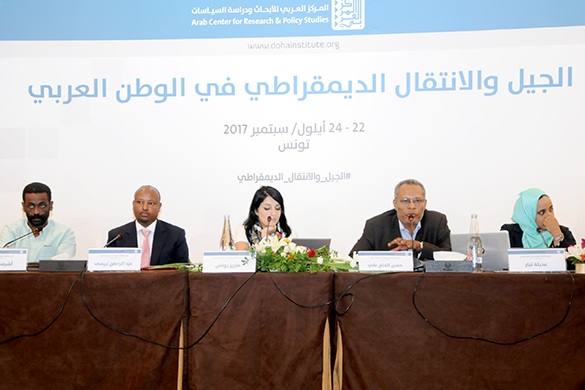The proceedings of the sixth annual Conference on Democratic Transition continued for the second day on Saturday, 23 September. The conference, hosted by the ACRPS office in Tunis, is devoted to the theme of “Arab Youth, the Generational Shift and Democratic Transition”, focusing on the impact of demographic shifts in the populations of Arab countries on the Arab Spring and increasing democratization.
 The first panel on this second day was moderated by ACRPS researcher Abdelfattah Madhy and dealt with the theme of “Islamist Youth: Political Orientation”. Mahmoud Abdelhafeez, speaking on that panel, used his presentation to argue that repression and security measures aimed at curbing political involvement by young Islamists were futile. Instead, argued Abdelhafeez, these measures simply allowed for a series of persistent political crises. Abdelhafeez also discussed the battle between Islamist youth and the state authorities across the region for dominance over nationalist rhetoric, in which Arab governments resorted to portraying any group clamoring for expanded political or economic rights as traitors to the nation.
The first panel on this second day was moderated by ACRPS researcher Abdelfattah Madhy and dealt with the theme of “Islamist Youth: Political Orientation”. Mahmoud Abdelhafeez, speaking on that panel, used his presentation to argue that repression and security measures aimed at curbing political involvement by young Islamists were futile. Instead, argued Abdelhafeez, these measures simply allowed for a series of persistent political crises. Abdelhafeez also discussed the battle between Islamist youth and the state authorities across the region for dominance over nationalist rhetoric, in which Arab governments resorted to portraying any group clamoring for expanded political or economic rights as traitors to the nation.
Abdelhafeez proceeded Mohammed Juweili, whose paper examined how Tunisian youth related to the Salafist ideology, particularly with regard to questions of faith, ideological belief and violence. Juweili, whose work was based on a field study surveying 1,200 young Tunisians between 18 and 30 years of age in the Governorate of Greater Tunis. Juweili reported the surprising result that 30% of young Tunisians included in his study stated that the Salafist conception of religious faith served their religious needs, while most of the respondents expressed the view that Salafism should not be a political force in their country. Similarly unexpectedly, however, more than 50% of Tunisian respondents expressed their acceptance of young girls wearing the hijab at primary schools and kindergartens. Juweili concluded that Salafism was successful in making inroads among young Tunisians because of its ability to strengthen social bonds. Juweili also expressed the view that the strength of Salafism among young Tunisians was due in part to the frailty of socializing institutions within the Tunisian state, which would have otherwise strengthened public confidence in the country’s secular ethos.
Abdelhafeez was followed on the panel by Egyptian scholar Yasser Fathy Mohammed, whose paper focused on the political orientation of the Muslim Brotherhood in Egypt, and specifically on the politicization of young Brotherhood members at Egyptian universities. Mohammed covered a number of issues, including a widely reported divergence between the official stance of the Muslim Brotherhood and its youth wing, explaining that the distinctions between these two groups developed gradually.

A second panel focused on Tunisian youth. The first speaker, Tunis-based Shaker Alhoukeen, focused on the duality of “youth” and “revolution” and on the role played by young Tunisians in the country’s revolution. Alhoukeen came to the conclusion that the generational shift alone could not explain the Tunisian revolution and, indeed, that such an approach could not produce a clear and coherent understanding of the Tunisian revolution. He concluded that, while young Tunisians played a clear role in the rebellion, attempts to depict Tunisia’s 2011 revolution as a “youth movement” were as misguided as attempts to write the youth out of the narrative of the Tunisian revolution.
ACRPS researchers Hamzeh Almoustafa and Sofia Hanezla closed this second panel with their joint paper covering the political conciliations which defined post-revolutionary Tunisia. Almoustafa argued that when political conciliations took place between traditional political blocs it froze out new forces from participating fully in the country’s political life, effectively creating a dormant political scene. Hanezla added that the marginalization of Tunisian youth, and the failure to address their economic, security and political concerns, also failed to benefit Tunisian political parties.